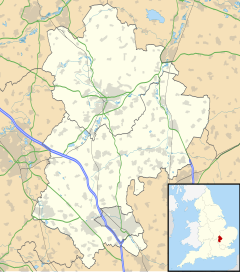Lidlington
| Lidlington | |
|---|---|
 Lidlington High Street |
|
| Lidlington shown within Bedfordshire | |
| Population | 1,347 (2011 Census) |
| OS grid reference | SP989390 |
| Civil parish |
|
| Unitary authority | |
| Ceremonial county | |
| Region | |
| Country | England |
| Sovereign state | United Kingdom |
| Post town | bedford |
| Postcode district | MK43 |
| Dialling code | 01525 |
| Police | Bedfordshire |
| Fire | Bedfordshire and Luton |
| Ambulance | East of England |
| EU Parliament | East of England |
Lidlington is a small village and civil parish in Central Bedfordshire, England surrounded by farmland, in the Marston Vale. The hamlets of Boughton End and Thrupp End are also part of the parish.
The village has an unusual Gothic-style church built by the Duke of Bedford in 1845 and a thatched pub on its High Street. Lidlington is set on the Southern part of the vale's 'basin'. The village has a lower school for 5–9 year olds named after Thomas Johnson, a Dick Whittington-type character who was Lord Mayor of London in 1840-41.
Brogborough Lake (also known as Lidlington Lake) at the edge of the village is popular for birdwatching and fishing. The lake is also used for windsurfing and stand up paddle surfing. The nearby landfill site (which was known as Brogborough Landfill site) was the largest landfill in Europe before closing to new deposits in 2009. With a population of about 1300 voters and over 500 homes, Lidlington is defined as a small village. It has a village hall, a pub, a hairdresser and a general store, plus a "farm store" on the A421. Lidlington has retained a daily doorstop milk and newspaper delivery service, but has lost its village post office. The village also has a single congregation Anglican/Baptist/Methodist church, members of which worship regularly in the chapel.
The village lies between the main A421 Bedford to Milton Keynes road and the A507 Ampthill to Woburn road. Lidlington railway station is on the Marston Vale Line which gives good access for walkers along the Greensand Ridge long distance footpath which passes nearby the village. Local speculation is that the ridge was the model for the "Delectable Mountains" in John Bunyan's Pilgrim's Progress. Lidlington Hill may also be Bunyan's "Hill of Difficulty".
...
Wikipedia

